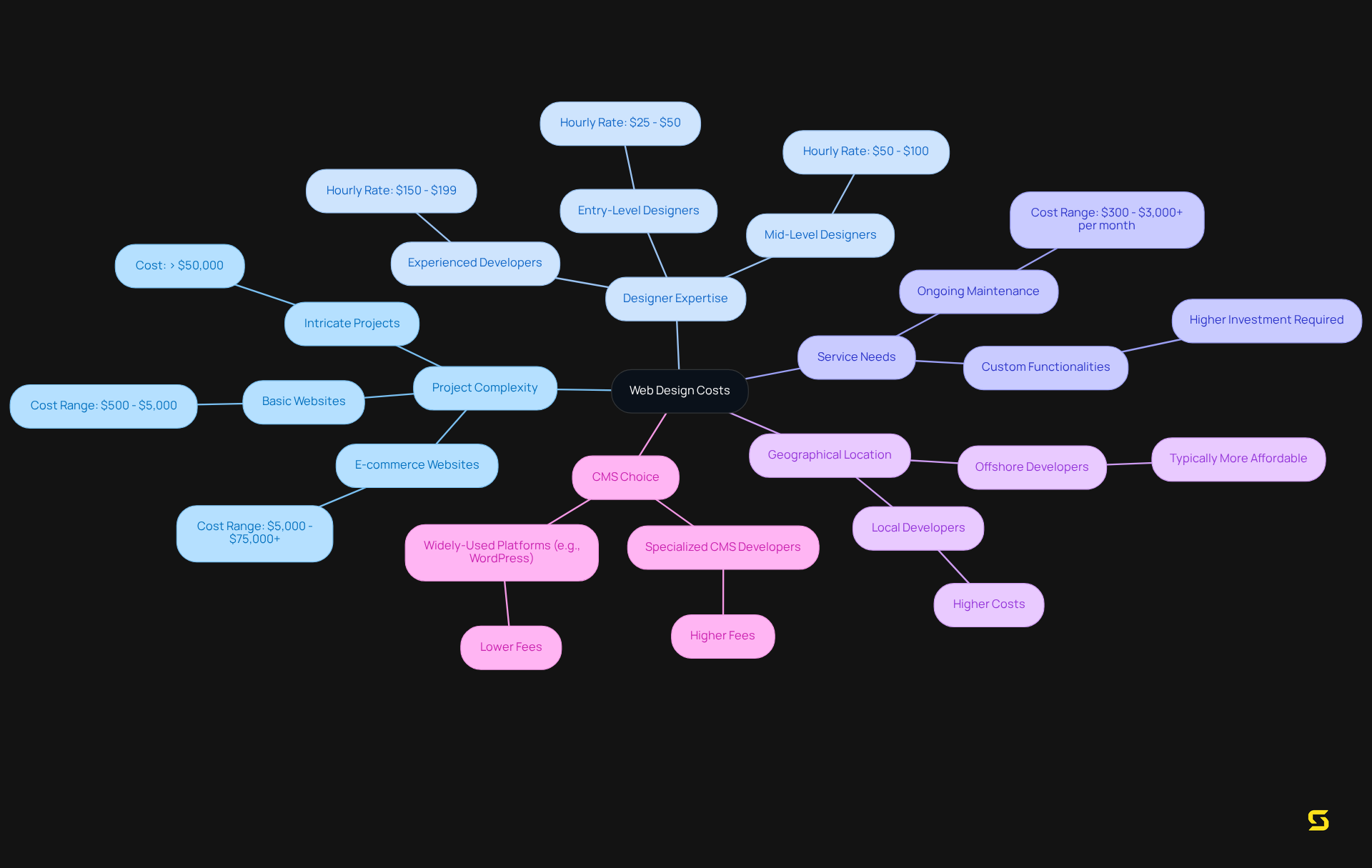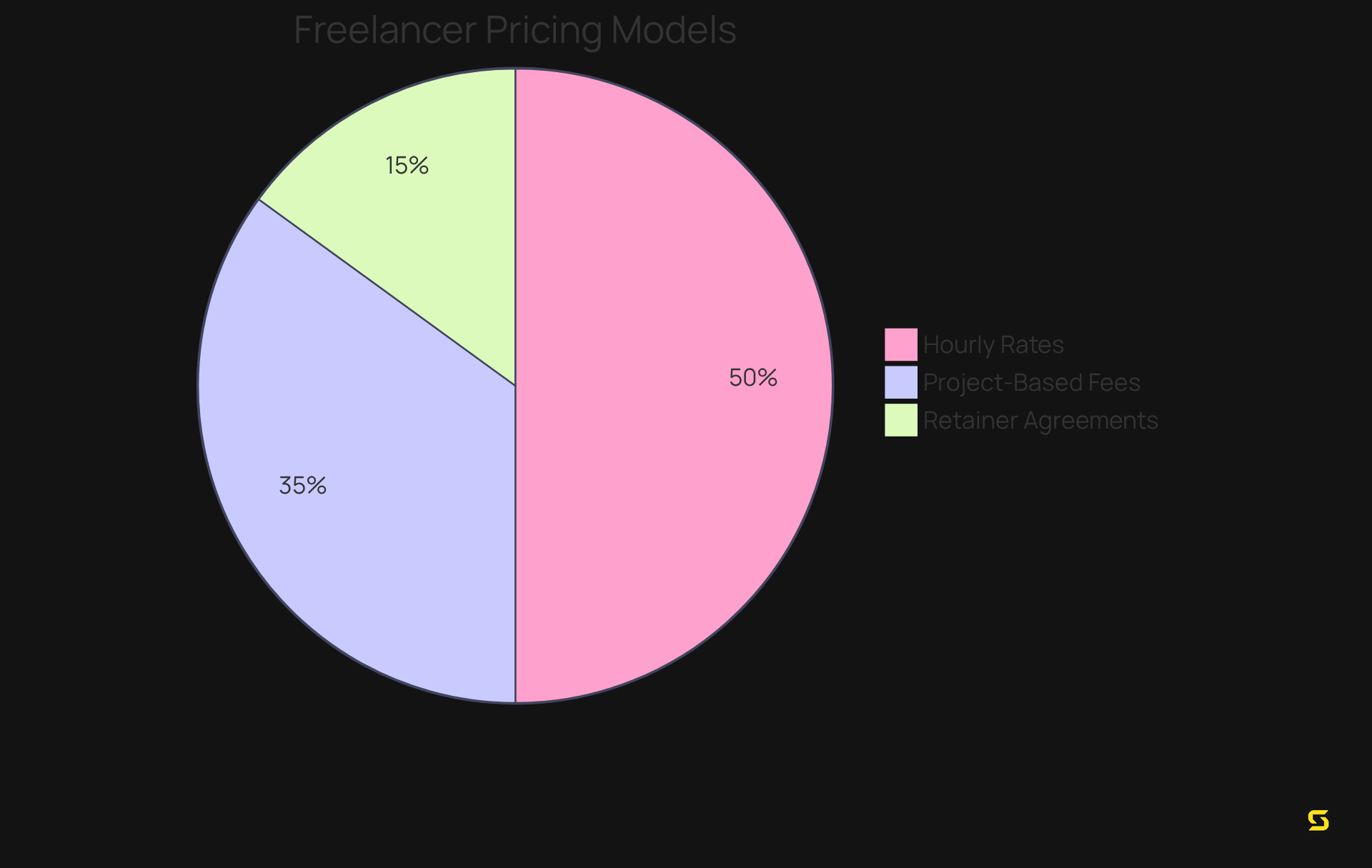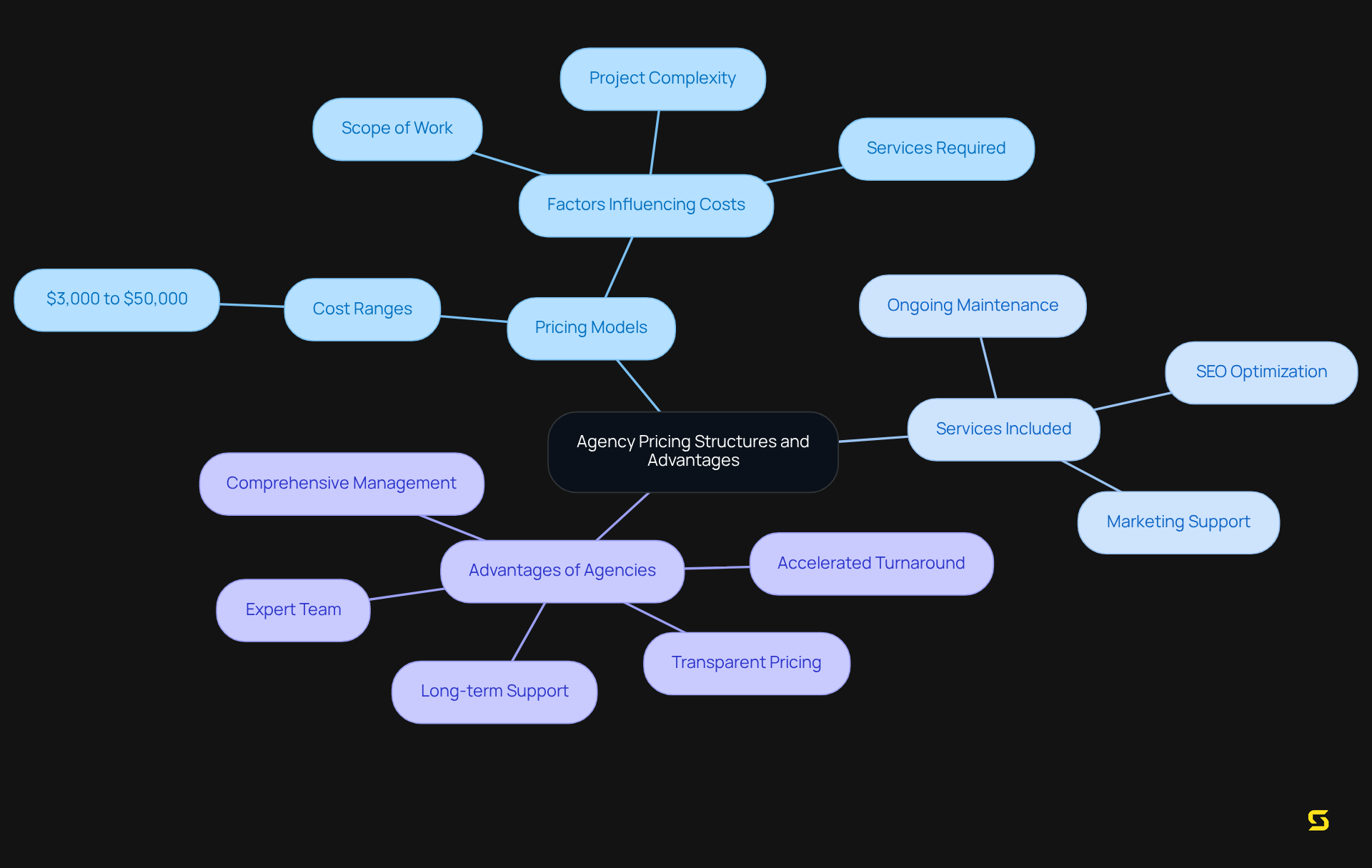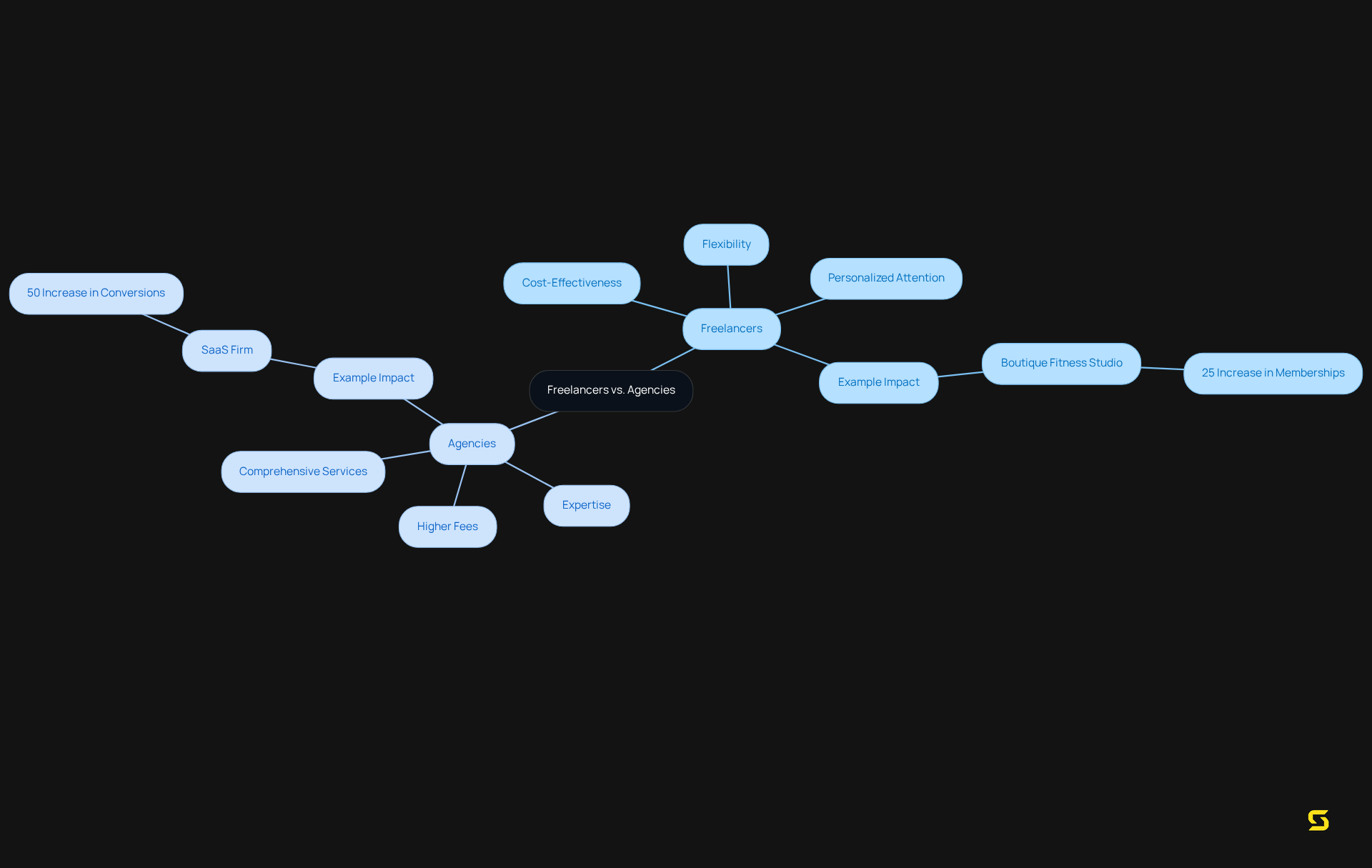Overview
This article offers a compelling comparison of web design costs between freelancers and agencies, establishing that freelancers typically provide more cost-effective solutions due to their lower overhead. In contrast, agencies are positioned as providers of comprehensive services that are particularly suitable for larger projects. This distinction is not merely theoretical; it is evidenced by numerous examples of businesses that have successfully leveraged both approaches.
Freelancers stand out in delivering personalized attention and flexibility, while agencies excel in offering extensive expertise and structured processes tailored for complex requirements. This nuanced understanding empowers businesses to make informed decisions based on their unique project needs.
Introduction
The landscape of web design presents a pivotal choice for businesses: should they engage freelancers or agencies for their digital needs? With costs varying dramatically—from a few hundred to tens of thousands of dollars—grasping the nuances of each option is essential for making an informed decision.
This article explores the comparative costs and benefits of hiring freelancers versus agencies, revealing how each can significantly influence project outcomes and overall business success.
Given the substantial investment involved, companies must carefully consider the factors that will ensure they select the right partner for their web design projects.
Understanding Web Design Costs
Web designing costs can vary significantly due to several factors, including complexity, designer expertise, and specific service needs. Basic websites typically range from $500 to $5,000, while more intricate projects can exceed $50,000. The total number of pages, the inclusion of features such as eCommerce capabilities, and the necessity for custom functionalities are key factors influencing web designing costs.
For instance, a basic landing page may cost anywhere from $300 for template-driven options to over $2,500 for fully personalized selections. Furthermore, ongoing maintenance and support can average between $300 and $3,000+ per month, depending on the site's complexity and the required level of management.
The geographical location of developers also impacts project costs, as offshore developers are often more affordable. Additionally, the choice of a content management system (CMS) can impact web designing costs, as specialized developers for certain CMS platforms typically charge higher fees than those experienced with widely-used platforms like WordPress.
Understanding these variables is crucial for businesses to effectively budget and select the right service provider. Companies that invest in quality website creation frequently experience significant long-term benefits, such as enhanced user engagement and improved brand perception, making it a worthy investment.

Freelancer Pricing Models and Benefits
Freelancers employ a range of pricing models, such as hourly rates, project-based fees, and retainer agreements. In 2025, hourly rates for freelancers typically span from $25 to $200, shaped by their experience and geographical location. Web designing costs can vary significantly based on task-based pricing; basic websites may start at approximately $6,500, while more complex projects can exceed $15,000, depending on specific needs and characteristics. For instance, the web designing costs for essential services tailored for small enterprises generally range from $6,500 to $15,000, ensuring that small businesses secure a reliable and user-friendly website that enhances customer engagement.
The advantages of engaging freelancers for web design projects are considerable. They often maintain lower overhead costs compared to agencies, which facilitates more competitive pricing. Additionally, freelancers provide direct communication, optimizing workflow and fostering collaboration. Their flexibility in project timelines proves particularly advantageous for businesses facing tight schedules or unique requirements. Moreover, freelancers frequently bring diverse experiences from various industries, allowing them to deliver customized solutions that align with specific business objectives. This adaptability, coupled with the potential for significant savings on web designing costs, positions freelancers as an appealing choice for organizations seeking to elevate their web development initiatives. A study indicates that 84% of businesses express satisfaction with the return on investment (ROI) from their web development efforts, further underscoring the value of investing in freelance web development services.

Agency Pricing Structures and Advantages
Web design firms typically implement structured pricing models, with web designing costs ranging from $3,000 to $50,000, influenced by factors such as project complexity and scope. Many organizations offer tiered pricing that includes various service levels, encompassing essential features such as SEO optimization, ongoing maintenance, and marketing support. Additionally, these organizations provide long-term support services, including updates and technical assistance, ensuring that websites remain operational and current.
The advantages of collaborating with an agency are significant: clients gain access to a diverse team of experts, enhancing quality and accelerating turnaround times. This collaborative approach is particularly beneficial for larger projects that require a broad range of skills and resources, guaranteeing comprehensive management and effective communication throughout the development process. In contrast, freelancers may not offer the same level of accountability and experience, which can lead to execution challenges.
Moreover, transparent pricing, including web designing costs, and well-defined objectives are crucial when selecting a digital marketing firm, as they help establish expectations and foster trust. Agencies often factor in potential risks associated with projects, such as delays in content delivery or revisions, within their pricing structures, providing clients with clearer insight into the value offered.

Comparative Analysis: Freelancers vs. Agencies
In the realm of web design, the choice between freelancers and firms presents distinct advantages and considerations. Freelancers often emerge as a more cost-effective option, particularly for smaller tasks, due to their lower overhead expenses. This financial efficiency enables them to provide competitive rates while upholding quality service. Their flexibility and personalized attention can facilitate quicker decision-making and a more customized approach to client needs. For example, a boutique fitness studio reported a 25% increase in memberships after collaborating with a freelancer for a rebrand, underscoring the potential impact of targeted freelance work.
Conversely, firms deliver a comprehensive range of services, including SEO, content development, and online marketing, paired with extensive expertise, making them ideal for larger, more complex projects that require diverse skill sets. While firms typically command higher fees, the organized processes and project oversight they offer can justify the investment for businesses seeking sustainable solutions. A SaaS firm, for instance, saw a 50% increase in conversions following a site redesign by a firm, highlighting the significance of a coordinated strategy. Moreover, it is noteworthy that 48% of individuals consider website design the primary factor in assessing a business's credibility, reinforcing the importance of quality design in both freelance and corporate environments.
Ultimately, the decision hinges on the project's scope and budget. Freelancers excel in providing specialized skills and flexibility for smaller projects, while agencies are better suited to manage intricate requirements, ensuring a robust and cohesive online presence.

Conclusion
The choice between freelancers and agencies for web design is a pivotal decision that can significantly influence the success and cost-effectiveness of a project. Understanding the nuances of web design costs is essential for businesses aiming to make informed choices that align with their specific needs and budgets. By evaluating the benefits and limitations of both options, organizations can strategically select the most suitable path for their web development initiatives.
Freelancers often provide a more personalized and flexible approach, making them ideal for smaller projects where cost efficiency is crucial. Their lower overhead allows for competitive pricing, while their diverse experiences can lead to tailored solutions that resonate with unique business objectives. Conversely, agencies offer a comprehensive suite of services and a collaborative team environment, which is particularly beneficial for larger, more complex projects requiring extensive expertise and resources. This structured approach can justify the higher costs associated with agency services, especially for businesses seeking long-term, sustainable results.
Ultimately, the decision should reflect the specific requirements of the project and the available budget. Whether opting for the agility and cost-effectiveness of freelancers or the robust capabilities of agencies, investing in quality web design is essential. A well-designed website not only enhances user engagement but also reinforces brand credibility, making it a critical component of any successful digital strategy. Companies are encouraged to weigh their options carefully and choose a path that aligns with their goals, ensuring that their online presence is both impactful and effective.
Frequently Asked Questions
What factors influence web design costs?
Web design costs are influenced by complexity, designer expertise, specific service needs, the total number of pages, inclusion of features like eCommerce capabilities, and the necessity for custom functionalities.
What is the typical cost range for basic websites?
Basic websites typically range from $500 to $5,000.
How much can more intricate web design projects cost?
More intricate projects can exceed $50,000.
What is the cost of a basic landing page?
A basic landing page may cost anywhere from $300 for template-driven options to over $2,500 for fully personalized selections.
What are the average costs for ongoing maintenance and support?
Ongoing maintenance and support can average between $300 and $3,000+ per month, depending on the site's complexity and management requirements.
How does geographical location affect web design costs?
The geographical location of developers impacts project costs, as offshore developers are often more affordable than local ones.
How does the choice of a content management system (CMS) impact web design costs?
The choice of CMS can affect costs, as specialized developers for certain platforms may charge higher fees than those experienced with widely-used platforms like WordPress.
Why is it important for businesses to understand web design costs?
Understanding web design costs is crucial for businesses to effectively budget and select the right service provider, as investing in quality website creation can lead to significant long-term benefits like enhanced user engagement and improved brand perception.





